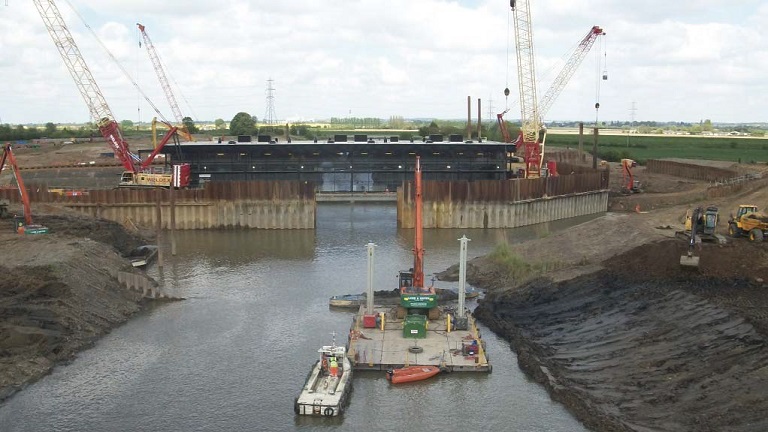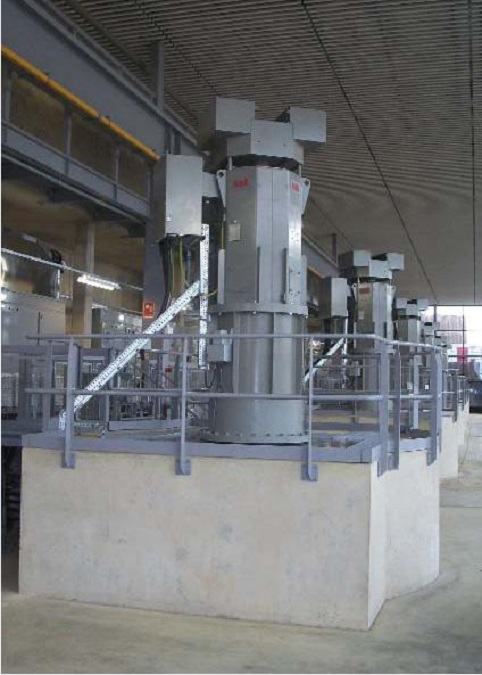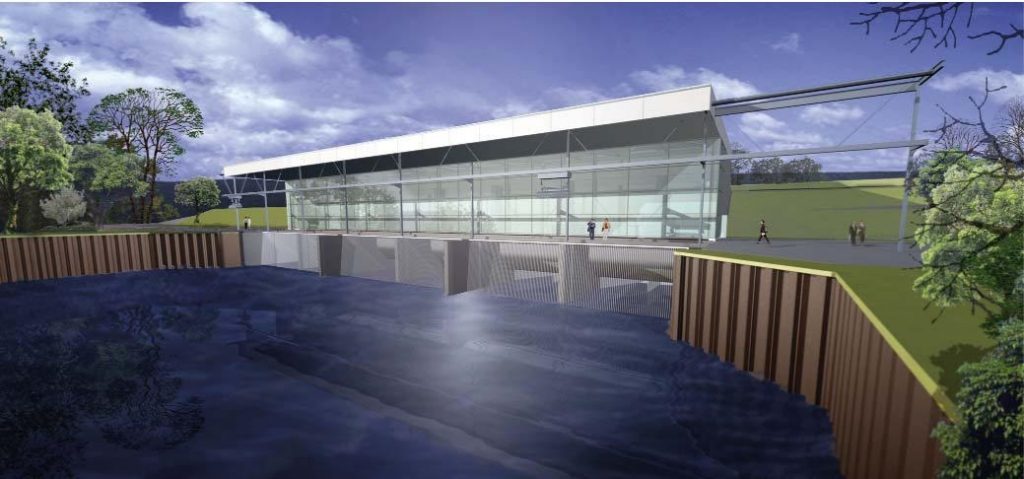St Germans Pumping Station (2010)

The St Germans Pumping Station is located in the village of Wigenhall St Germans near Kings Lynn in Norfolk. The station, owned by Middle Level Commissioners (MLC), is constructed on the Middle Level Main Drain and lifts storm water and land drainage to the tidal River Ouse. The station provides flood protection for 24,000 private properties, 1,100 commercial properties and 70,000 hectares of high grade agricultural land. The original pumping station was constructed in 1934 with three double entry split casing Gwynnes pumps driven by diesel engines. A fourth pump was added in the 1950s giving the station a total capacity of 70 cubic metres per second.
The Challenge
In 1998, the station was subjected to a 1-in-14-year storm event and ran continuously for 12 days. The pumps were then 64-years old and were proving very expensive to maintain, with spare parts often no longer available. Similarly, the knowledge base for the old white metal bearing technology was becoming increasingly difficult to obtain as the industry has embraced newer forms of technology. MLC decided it was time to review the facility and the system it served and commissioned a catchment strategy study, which identified that the station capacity should be increased from the 70 cumec to 100 cumec.
The Solution
Atkins was employed to undertake the upgrade in three phases:
Phase One
This required a feasibility/option study and initial environmental impact assessment (EIA). The option study examined the outline designs and life costs of a new station. It compared six new concrete volute pumps, eight bowl pumps and six humpback pumps with refurbishment of the existing pumping station with four humpback pumps. In addition it considered seven locations for the new station, three online and four offline of the Middle Level Main Drain. The total power requirement would be 7.5 megawatts, so a range of differing power options were considered, including direct diesel, gas engine powered and electric with a number of combinations of dedicated generated power (including wind) and mains power.
The environment around St Germans presented some significant challenges and it was essential that the old pumping station remained operational until the new one was completed. The open flat landscape means that noise carries large distances and any new structures can potentially impact on visual amenity over a wide area. There is also a wealth of sensitive ecological and heritage features in and around the pumping station.
Phase Two
Atkins submitted the economic justification of the scheme to Defra for grant aid. This demonstrated the following key findings:
- The drainage and flood defence of the Middle Level system is dependant on the St Germans Pumping Station, which is close to the end of its usable life;
- Implementation of the preferred option will raise the standard of protection to cope with a 1-in-100-year rainfall event and allows for predicted changes in climate up until 2050;
- The preferred option comprises the replacement of the station with pumps of a concrete volute type downstream of the existing pumping station;
- Capital cost: £38m;
- PV benefits: £912.6m;
- Benefit / Cost ratio:17.83;
- Defra priority score: 31.
Phase three
This included detailed design, environmental statement planning, waste management exemption, OJEU, tender and implementation. The detailed design utilised all engineering disciplines, notably geotechnical, structural, civil, architectural, mechanical and electrical, and ICA.
In addition, a traffic survey and route option study was undertaken to minimise the effects of the construction traffic on the rural village location. This led to the upgrading of 4km of unclassified road and the inclusion of a temporary main drain bridge and 2km of across-country temporary road in the works.
The Environmental Statement formed a significant element of the planning application. Atkins worked closely with regulators, the planning authorities and MLC through the application process to obtain the necessary consents and address concerns of nearby residents. For example, Atkins worked with the Environment Agency to minimise the amount of waste going to landfill, successfully obtaining an exemption allowing the reuse of 150,000 cubic metres of material in the construction and landscaping. In all instances, Atkins sought to avoid or minimise environmental impacts by adjusting the design and proposed construction methods.
OJEU notices were issued and submissions received and evaluated to produce the short lists for three contracts:
- Lot 1: The 6 No. main concrete volute pumps – Awarded to KSB/Bosman Pumps
- Lot 2: All mechanical, electrical, instrumentation, control and automation works (MEICA) – Awarded to Birse Water
- Lot 3: All the building and civil works – Awarded to Costain
As the pumps are concrete volute and the inlet, volute and discharge form an integral part of the civil structure, the Lot 1 contract was awarded in advance of the completion of the designs from Lots 2 and 3. This enabled critical and particular design information from the pump manufacturers to be fed into the civil and MEICA designs before these were issued for tender.
Throughout the design and tender period, Atkins worked closely with the local electricity supplier, EDF, to ensure the replacement of the existing substation would meet the increased power demand. That it was unlikely that more than three pumps would run together in any three-year period for normal pump operation was taken into account in sizing the substation, as was the fact that the flood risk causing all six pumps running together would only occur following a 1-in-100 year rainfall event. The design incorporates full diesel generator standby power and, to reduce cost, the new substation has been sized to power a maximum of three of the six pumps. In the event that more than three pumps are required, the diesel generators will be used to power the additional pumps. Any combination of the six pumps can be powered by mains power and diesel generator power. The design also includes a solution should there be a mains failure situation as all six pumps can be powered by the diesel generators if required.

Inside the pump hall and shows the six motor and gearbox drives for the pumps – Courtesy of Atkins
![]() Technical aspects of the design
Technical aspects of the design
Lot 1: six concrete volute mains pumps
- 690V 1.25MW air-cooled electric motor drive through a speed reducing gearbox;
- Air-cooled frequency inverters provide variable speed control;
- Each pump is rated a 16.6 cubic metres per second at a primary duty static head of 4.25m at 127 rpm (NPSHr 7.2m above absolute zero based on 3% bell length) and 12.6 cubic metres per second at a secondary maximum static head of 6.87m (NPSHr 12.86m above absolute based on 6% bell length);
- The pumps incorporate a ceramic main axial bearing below the water line and a two-stage liquidyne main water seal;
- The total weight of each pump assembly is approximately 50 tonnes.
Lot 2: MEICA works:
- 65m wide by 7m deep inlet course screens with two automated screenings grabs;
- 6 No. 4.5m by 3.5m hydraulically powered pensocks;
- 6 No. 4.5m by 4.5m non return flap valves;
- 11kV switchgear and 6 No. 11kV/690V transformers;
- 6 No. 1.5MVA diesel generators each dedicated to a single pump;
- 6 No. 11m long motor control centres;
- Auxiliary 11kV/415V transformer and switchgear.
Lot 3: main civil and building works:
- The pumping station has been constructed in the dry within a 280m long twin walled 10m – 13m wide cofferdam with 21m long piles;
- The pump building is a reinforced concrete structure to BS8007, which incorporates five key levels with a footprint that measures 70m by 44m;
- More than 13,000 cubic metres of concrete has been poured with selected walls using waterproof concrete;
- The structure is founded on some 468 CFA fully-reinforced piles that range in length from 11m – 19m and diameters from 600mm – 900mm;
- The base of the station sits predominantly on a firm Kimmeridge clay layer.
The above ground building is architecturally significant. The superstructure is steel framed with more that 50 percent of the exposed faces in double-glazed, self-cleansing units. Non-glazed faces are clad in aluminium rain screen panels.
The channel works design incorporates permanent steel sheet piles into the 80m-wide inlet and 30m-wide outlet to the station.

Original architect’s impression of inlet to new station – Courtesy of Atkins
![]() Current construction and operational status
Current construction and operational status
The pumping station was commissioned within the cofferdam in March and early April 2010. By late April 2010, the cofferdam was opened sufficiently to allow the new station to be brought on line and take over from the old station. The current works to completion include full removal of the cofferdam, demolition of the existing pumping station, channel profiling and construction of the permanent access roads. Final completion is programmed for December 2010.


